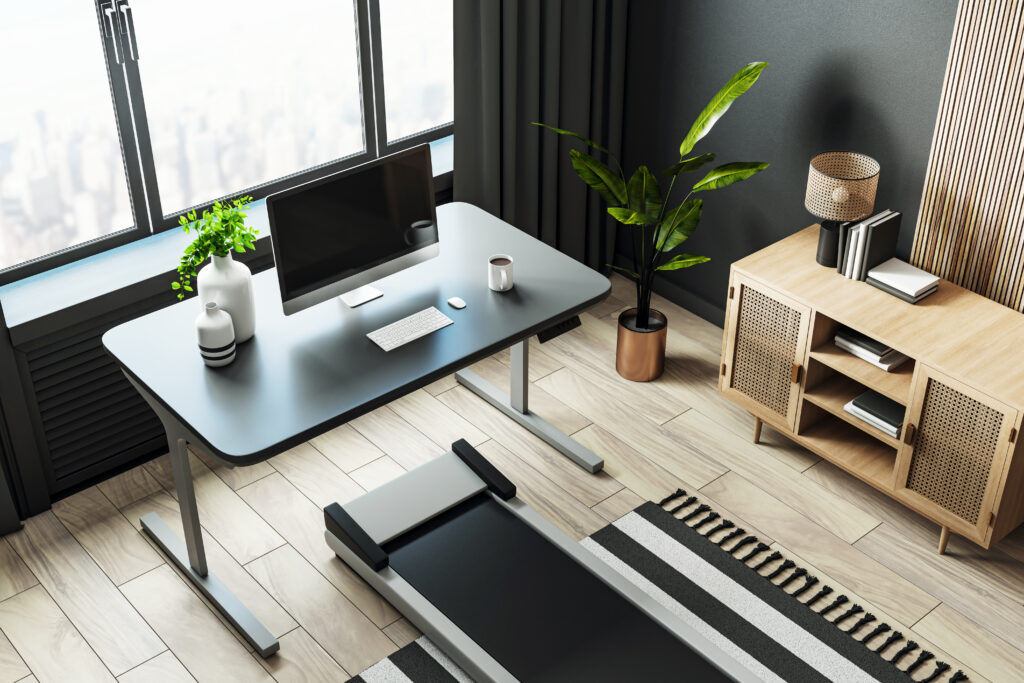

Columns/Blogs
Employee Wellness
Are active workstations the future of office design and employee health?
August 25, 2025
By Mia Barnes
 Credit: Adobe Stock/Who is Danny.
Credit: Adobe Stock/Who is Danny. Canadian employers have spent decades grappling with a problem — too much sitting. On average, office workers spend more hours a day sedentary, sitting in a fixed position on non-ergonomic chairs that cause joint, muscle, and other physical ailments.
Prolonged sitting is tied to cardiovascular disease, obesity, musculoskeletal pain and even lower cognitive performance. While ergonomically designed chairs and height-adjustable desks help, new approaches can reshape office design. Active workstations — with treadmills, under-desk pedal machines or yoga balls — could be your next step toward healthier, more productive workplaces.
Why sitting is a risk employers can’t ignore
Medical research consistently links sedentary time to poor health outcomes. A 2023 systematic review found that workplace physical activity interventions improved cardiorespiratory fitness and muscle strength and reduced musculoskeletal symptoms among employees. For HR leaders, a sedentary workforce isn’t just a wellness issue — it’s also a productivity drain. Workers who sit most of the day are more likely to take sick leave, report fatigue and struggle with mental engagement.
The rise of active workstations
Unlike traditional setups, active workstations encourage daily movement without interrupting work. Instead of expecting employees to hit the gym before or after office hours, you can use tools to integrate exercise directly into the workday since physical activity improves physical well-being and mental health.
Early adoption is most common in tech firms, government wellness programs and universities, where pilot projects show promising results and easy acceptance by participants. The most popular active workstations include standing desks, walking pads or treadmills, elliptical machines and stationary cycling.
Standing desks
Standing desks remain the most widespread form of active workstation. While they don’t burn many extra calories, they reduce prolonged sitting, which can increase the risk of cardiovascular complications that lead to poor health. Workers may also report less back pain and experience greater alertness after transitioning to sit-stand desks.
Walking pads, treadmill and cycling desks
For increased performance, cycling desks take the cake. Participants experience significantly reduced boredom and increased mental arousal while using these active workstations. Walking pads and treadmill workstations may further promote movement in a sedentary day, providing mental stimulation that a standing desk may lack. However, if you choose to use this setup, you should consider space, safety and employee health.
Under-desk ellipticals
Under-desk elliptical machines offer a compact solution if you’re hesitant to overhaul your floor plans. Employees can pedal discreetly while seated. Combining physical activity and easy application makes this a viable option for hybrid workspaces where space is limited but wellness initiatives remain a priority.
For those with limited mobility and fitness, an easy introduction is 30 seconds of activity followed by a 30-second rest, repeated a few times throughout the day. This prevents blood pooling in the legs, which could cause vascular damage and heart disease.
Yoga ball chairs
Yoga balls or stability ball chairs are not only for gyms. Sitting on an unstable surface can free you from locked-in joint positions, activate your core muscles and reduce static strain on the spine. Seated exercise is beneficial for older employees, but a hybrid yoga ball chair can act as an intermediary between exercising and using dynamic seating while working. This type of seating benefits creative spaces like brainstorming rooms, where alertness guides creation.
Vibrating plates
Vibration plates, once a niche fitness tool, are finding a place in wellness-focused offices. While less common, you can use these during short breaks to stimulate circulation and reduce stiffness. Vibration training supports muscle strength by stimulating blood flow and lymphatic drainage — two issues that those in sedentary work often struggle with. Adoption in professional settings remains experimental, but the benefits may soon have staff shaking it up.
A business case for active workstations
You’ll find the return on investment comes in two forms — reduced health risks and improved productivity. Workplaces that foster physical activity — with open areas that encourage employees to stretch and move more instead of cubicle-style designs — have measurable mental and physical health gains. You’ll benefit from lower absenteeism and improved morale, which are key factors in talent retention.
If simply having room to stretch and move has a significant impact, imagine what changing to active workstations can accomplish. As hybrid models blur the lines between home and office, organizations adopting flexible, active setups stand to attract and retain health-conscious employees.
Tips for creating active workstations
A few considerations you should examine before rushing out to buy yoga balls or elliptical machines include:
- Cost vs. benefit: Standing desks are affordable and widely adopted, while treadmill desks and vibrating plates carry higher price tags. Yoga balls are versatile and cost-effective, but you shouldn’t sit on one for more than 90 minutes per session to prevent overexertion.
- Space planning: Walking pads or cycling desks require more square footage and may not fit in every office.
- Safety and liability: Proper training and ergonomic assets are crucial to prevent misuse and injury.
- Culture shift: Leadership buy-in matters. Your employees need to feel encouraged to use these machines, not self-conscious.
Are active workstations a fad or the future?
Evidence points to active workstations as more than a passing trend. No single solution ever fits all workplaces. These tools align with broader public health campaigns urging Canadians to reduce sedentary time. As an employer, you should offer healthier choices and integrate daily activity into the workday.
Mia Barnes is the editor-in-chief at Body+Mind.